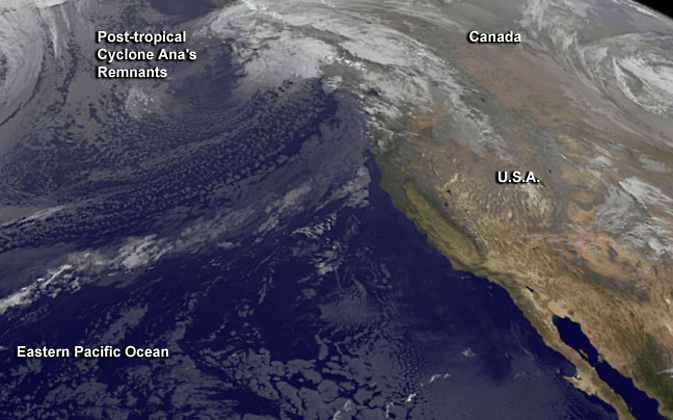Ana's Remnants Raining and Gusting in British Columbia, Canada

Post-tropical cyclone Ana's remnant clouds resemble a frontal system in this image from NOAA's GOES-West satellite. Image Credit: NASA/NOAA GOES Project
Wind warnings along some coastal sections of British Columbia continued today as the storm moved through the region.
NOAA's GOES-West satellite gathered infrared data on Ana's remnant clouds and that data was made into an image by NASA/NOAA's GOES Project at NASA's Goddard Space Flight Center in Greenbelt, Maryland. In the image the remnant clouds resemble a frontal system.
Environment Canada's Meteorological Service continued wind warnings for British Columbia's Central coast, East Vancouver Island, North Vancouver Island and the Sunshine Coast The warning noted strong winds may cause damage. Strong southeast winds of 56 mph (90 kph) over exposed coastal sections will continue during the morning of Oct. 28.
At 8 a.m. EDT on Oct. 28, Victoria Int'l Airport in Victoria, British Columbia reported light rain with sustained winds near 21 mph (34 kph) and gusts to 29 mph (47 kph). Vancouver International Airport reported light rain with sustained winds near 16 mph (26 kph) from the east.
The local forecast calls for skies to clear as the remnants of Ana to move east by Wednesday, Oct. 29.
Environment Canada meteorologists will update alerts as required. For updates, visit: http://weather.gc.ca.
Rob Gutro
NASA's Goddard Space Flight Center
Media Contact
More Information:
http://www.nasa.gov/content/goddard/ana-central-pacific/All latest news from the category: Earth Sciences
Earth Sciences (also referred to as Geosciences), which deals with basic issues surrounding our planet, plays a vital role in the area of energy and raw materials supply.
Earth Sciences comprises subjects such as geology, geography, geological informatics, paleontology, mineralogy, petrography, crystallography, geophysics, geodesy, glaciology, cartography, photogrammetry, meteorology and seismology, early-warning systems, earthquake research and polar research.
Newest articles

A universal framework for spatial biology
SpatialData is a freely accessible tool to unify and integrate data from different omics technologies accounting for spatial information, which can provide holistic insights into health and disease. Biological processes…

How complex biological processes arise
A $20 million grant from the U.S. National Science Foundation (NSF) will support the establishment and operation of the National Synthesis Center for Emergence in the Molecular and Cellular Sciences (NCEMS) at…

Airborne single-photon lidar system achieves high-resolution 3D imaging
Compact, low-power system opens doors for photon-efficient drone and satellite-based environmental monitoring and mapping. Researchers have developed a compact and lightweight single-photon airborne lidar system that can acquire high-resolution 3D…





















